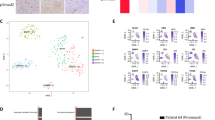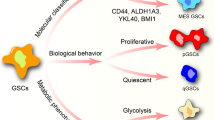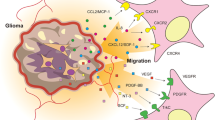Abstract
The study of neural stem cell and progenitor cell biology has improved our understanding of the biology of brain tumors in a developmental context. Recent work has demonstrated that brain tumors may harbor small subpopulations of cells that share characteristics of neural stem cells. There is still an ongoing debate about the specific role of these stem-like cells in cancer initiation, development and progression. Nonetheless, the concept of cancer stem cells has offered a new paradigm to understand tumor biology and resistance to current treatment modalities. Molecular aberrations in these cancer stem cells might be crucial targets for therapeutic intervention, with the hope of achieving more durable clinical responses. Recent studies have demonstrated that endogenous and transplanted neural stem cells and progenitor cells show a marked tropism to brain tumors. Although the mechanisms that govern these processes are poorly understood, the use of neural stem cells and progenitor cells as delivery vehicles for molecules toxic to tumors offers a promising experimental treatment strategy. This Review summarizes recent advances in the basic understanding of neural stem cell and cancer stem cell biology and the progress towards translating these novel concepts into the clinic.
Key Points
-
Cancer stem cells can be found in malignant gliomas and could be responsible for tumor initiation, tumor progression and resistance to current treatment strategies
-
Understanding the behavior and signaling in normal neural stem cell and progenitor cells will provide essential clues about genetic or epigenetic alterations in cancer stem cells and will be essential to developing successful novel therapies
-
A better understanding of 'stem cell niches' in the adult brain will allow essential insights into tumor behavior and treatment resistance
-
The analysis of purified cancer stem and progenitor cell populations with the development of novel lineage markers are likely to have an important impact on tumor classification and the debate about the 'cell-of-origin' in gliomas
-
The use of transplanted or endogenous progenitor cell populations might offer a powerful tool for promising future therapies to target dispersed cancer cells
This is a preview of subscription content, access via your institution
Access options
Subscribe to this journal
Receive 12 print issues and online access
$209.00 per year
only $17.42 per issue
Buy this article
- Purchase on Springer Link
- Instant access to full article PDF
Prices may be subject to local taxes which are calculated during checkout





Similar content being viewed by others
References
Clarke MF and Fuller M (2006) Stem cells and cancer: two faces of eve. Cell 124: 1111–1115
Lapidot T et al. (1994) A cell initiating human acute myeloid leukaemia after transplantation into SCID mice. Nature 367: 645–648
Bonnet D and Dick JE (1997) Human acute myeloid leukemia is organized as a hierarchy that originates from a primitive hematopoietic cell. Nat Med 3: 730–737
Reya T et al. (2001) Stem cells, cancer, and cancer stem cells. Nature 414: 105–111
Tan BT et al. (2006) The cancer stem cell hypothesis: a work in progress. Lab Invest 86: 1203–1207
Vescovi AL et al. (2006) Brain tumour stem cells. Nat Rev Cancer 6: 425–436
Jordan CT et al. (2006) Cancer stem cells. N Engl J Med 355: 1253–1261
Dietrich J et al. (2006) CNS progenitor cells and oligodendrocytes are targets of chemotherapeutic agents in vitro and in vivo. J Biol 5: 22
Reynolds BA and Weiss S (1992) Generation of neurons and astrocytes from isolated cells of the adult mammalian central nervous system. Science 255: 1707–1710
Temple S and Alvarez-Buylla A (1999) Stem cells in the adult mammalian central nervous system. Curr Opin Neurobiol 9: 135–141
Gage FH (2000) Mammalian neural stem cells. Science 287: 1433–1438
Mayer-Proschel M et al. (1997) Isolation of lineage-restricted neuronal precursors from multipotent neuroepithelial stem cells. Neuron 19: 773–785
Rao MS et al. (1998) A tripotential glial precursor cell is present in the developing spinal cord. Proc Natl Acad Sci USA 95: 3996–4001
Dietrich J et al. (2002) Characterization of A2B5+ glial precursor cells from cryopreserved human fetal brain progenitor cells. Glia 40: 65–77
Palmer TD et al. (2000) Vascular niche for adult hippocampal neurogenesis. J Comp Neurol 425: 479–494
Shen Q et al. (2004) Endothelial cells stimulate self-renewal and expand neurogenesis of neural stem cells. Science 304: 1338–1340
Alvarez-Buylla A and Lim DA (2004) For the long run: maintaining germinal niches in the adult brain. Neuron 41: 683–686
Sanai N et al. (2004) Unique astrocyte ribbon in adult human brain contains neural stem cells but lacks chain migration. Nature 427: 740–744
Quinones-Hinojosa A et al. (2006) Cellular composition and cytoarchitecture of the adult human subventricular zone: a niche of neural stem cells. J Comp Neurol 494: 415–434
Eriksson PS et al. (1998) Neurogenesis in the adult human hippocampus. Nat Med 4: 1313–1317
Luskin MB (1993) Restricted proliferation and migration of postnatally generated neurons derived from the forebrain subventricular zone. Neuron 11: 173–189
Lois C et al. (1996) Chain migration of neuronal precursors. Science 271: 978–981
Curtis MA et al. (2007) Human neuroblasts migrate to the olfactory bulb via a lateral ventricular extension. Science 315: 1243–1249
Altman J and Das GD (1965) Autoradiographic and histological evidence of postnatal hippocampal neurogenesis in rats. J Comp Neurol 124: 319–335
Kuhn HG et al. (1996) Neurogenesis in the dentate gyrus of the adult rat: age-related decrease of neuronal progenitor proliferation. J Neurosci 16: 2027–2033
Hastings NB et al. (2002) Granule neurons generated during development extend divergent axon collaterals to hippocampal area CA3. J Comp Neurol 452: 324–333
Cameron HA and McKay RD (2001) Adult neurogenesis produces a large pool of new granule cells in the dentate gyrus. J Comp Neurol 435: 406–417
Nunes MC et al. (2003) Identification and isolation of multipotential neural progenitor cells from the subcortical white matter of the adult human brain. Nat Med 9: 439–447
Marmur R et al. (1998) Isolation and developmental characterization of cerebral cortical multipotent progenitors. Dev Biol 204: 577–591
Arsenijevic Y et al. (2001) Isolation of multipotent neural precursors residing in the cortex of the adult human brain. Exp Neurol 170: 48–62
Coles BL et al. (2004) Facile isolation and the characterization of human retinal stem cells. Proc Natl Acad Sci USA 101: 15772–15777
Temple S (2001) The development of neural stem cells. Nature 414: 112–117
Hitoshi S et al. (2002) Neural stem cell lineages are regionally specified, but not committed, within distinct compartments of the developing brain. Development 129: 233–244
Shen Q et al. (2006) The timing of cortical neurogenesis is encoded within lineages of individual progenitor cells. Nat Neurosci 9: 743–751
Goldman JE et al. (1997) Fate determination and migration of progenitors in the postnatal mammalian CNS. Dev Neurosci 19: 42–48
Marshall CA et al. (2003) Gliogenic and neurogenic progenitors of the subventricular zone: who are they, where did they come from, and where are they going? Glia 43: 52–61
Lie DC et al. (2004) Neurogenesis in the adult brain: new strategies for central nervous system diseases. Annu Rev Pharmacol Toxicol 44: 399–421
Imitola J et al. (2004) Stem cells: cross-talk and developmental programs. Philos Trans R Soc Lond B Biol Sci 359: 823–837
Singh SK et al. (2004) Identification of human brain tumour initiating cells. Nature 432: 396–401
Dietrich J and Kempermann G (2006) Role of endogenous neural stem cells in neurological disease and brain repair. Adv Exp Med Biol 557: 191–220
Gupta T and Sarin R (2002) Poor-prognosis high-grade gliomas: evolving an evidence-based standard of care. Lancet Oncol 3: 557–564
Maher EA et al. (2001) Malignant glioma: genetics and biology of a grave matter. Genes Dev 15: 1311–1333
Lacroix M et al. (2001) A multivariate analysis of 416 patients with glioblastoma multiforme: prognosis, extent of resection, and survival. J Neurosurg 95: 190–198
Kleihues P et al. (2002) The WHO classification of tumors of the nervous system. J Neuropathol Exp Neurol 61: 215–225
Pardal R et al. (2003) Applying the principles of stem-cell biology to cancer. Nat Rev Cancer 3: 895–902
Jordan CT and Guzman ML (2004) Mechanisms controlling pathogenesis and survival of leukemic stem cells. Oncogene 23: 7178–7187
Wang JC and Dick JE (2005) Cancer stem cells: lessons from leukemia. Trends Cell Biol 15: 494–501
van Rhenen A et al. (2005) High stem cell frequency in acute myeloid leukemia at diagnosis predicts high minimal residual disease and poor survival. Clin Cancer Res 11: 6520–6527
Al-Hajj M et al. (2003) Prospective identification of tumorigenic breast cancer cells. Proc Natl Acad Sci USA 100: 3983–3988
Li Y and Rosen JM (2005) Stem/progenitor cells in mouse mammary gland development and breast cancer. J Mammary Gland Biol Neoplasia 10: 17–24
Shackleton M et al. (2006) Generation of a functional mammary gland from a single stem cell. Nature 439: 84–88
Matsui W et al. (2004) Characterization of clonogenic multiple myeloma cells. Blood 103: 2332–2336
Collins AT and Maitland NJ (2006) Prostate cancer stem cells. Eur J Cancer 42: 1213–1218
O'Brien CA et al. (2007) A human colon cancer cell capable of initiating tumour growth in immunodeficient mice. Nature 445: 106–110
Ricci-Vitiani L et al. (2007) Identification and expansion of human colon-cancer-initiating cells. Nature 445: 111–115
Ignatova TN et al. (2002) Human cortical glial tumors contain neural stem-like cells expressing astroglial and neuronal markers in vitro. Glia 39: 193–206
Singh SK et al. (2003) Identification of a cancer stem cell in human brain tumors. Cancer Res 63: 5821–5828
Hemmati HD et al. (2003) Cancerous stem cells can arise from pediatric brain tumors. Proc Natl Acad Sci USA 100: 15178–15183
Yuan X et al. (2004) Isolation of cancer stem cells from adult glioblastoma multiforme. Oncogene 23: 9392–9400
Galli R et al. (2004) Isolation and characterization of tumorigenic, stem-like neural precursors from human glioblastoma. Cancer Res 64: 7011–7021
Bao S et al. (2006) Stem cell-like glioma cells promote tumor angiogenesis through vascular endothelial growth factor. Cancer Res 66: 7843–7848
Beier D et al. (2007) CD133(+) and CD133(−) glioblastoma-derived cancer stem cells show differential growth characteristics and molecular profiles. Cancer Res 67: 4010–4015
Bao S et al. (2006) Glioma stem cells promote radioresistance by preferential activation of the DNA damage response. Nature 444: 756–760
Dean M et al. (2005) Tumour stem cells and drug resistance. Nat Rev Cancer 5: 275–284
Piccirillo SG et al. (2006) Bone morphogenetic proteins inhibit the tumorigenic potential of human brain tumour-initiating cells. Nature 444: 761–765
Fan X et al. (2007) Glioma stem cells: evidence and limitation. Semin Cancer Biol 17: 214–218
Jellinger K (1978) Glioblastoma multiforme: morphology and biology. Acta Neurochir (Wien) 42: 5–32
Kleihues P and Ohgaki H (2000) Phenotype vs genotype in the evolution of astrocytic brain tumors. Toxicol Pathol 28: 164–170
Noble M and Dietrich J (2002) Intersections between neurobiology and oncology: tumor origin, treatment and repair of treatment-associated damage. Trends Neurosci 25: 103–107
Ligon KL et al. (2007) Olig2-regulated lineage-restricted pathway controls replication competence in neural stem cells and malignant glioma. Neuron 53: 503–517
Shiras A et al. (2007) Spontaneous transformation of human adult non-tumorigenic stem cells to cancer stem cells is driven by genomic instability in a human model of glioblastoma. Stem Cells 25: 1478–1489
Kakita A and Goldman JE (1999) Patterns and dynamics of SVZ cell migration in the postnatal forebrain: monitoring living progenitors in slice preparations. Neuron 23: 461–472
Recht L et al. (2003) Neural stem cells and neuro-oncology: quo vadis? J Cell Biochem 88: 11–19
Sanai N et al. (2005) Neural stem cells and the origin of gliomas. N Engl J Med 353: 811–822
Jackson EL et al. (2006) PDGFR alpha-positive B cells are neural stem cells in the adult SVZ that form glioma-like growths in response to increased PDGF signaling. Neuron 51: 187–199
Globus JH and Kuhlenbeck H (1944) Subependymal cell plate (matrix) and its relationship to brain tumors of ependymal type. J Neuropathol 3: 1–35
Vick NA et al. (1977) The role of the subependymal plate in glial tumorigenesis. Acta Neuropathol (Berl) 40: 63–71
Barnett SC et al. (1998) Oligodendrocyte-type-2 astrocyte (O-2A) progenitor cells transformed with c-myc and H-ras form high-grade glioma after stereotactic injection into the rat brain. Carcinogenesis 19: 1529–1537
Bachoo RM et al. (2002) Epidermal growth factor receptor and Ink4a/Arf: convergent mechanisms governing terminal differentiation and transformation along the neural stem cell to astrocyte axis. Cancer Cell 1: 269–277
Uhrbom L et al. (2005) Cell type-specific tumor suppression by Ink4a and Arf in Kras-induced mouse gliomagenesis. Cancer Res 65: 2065–2069
Ligon KL et al. (2006) Development of NG2 neural progenitor cells requires Olig gene function. Proc Natl Acad Sci USA 103: 7853–7858
Noble M and Dietrich J (2004) The complex identity of brain tumors: emerging concerns regarding origin, diversity and plasticity. Trends Neurosci 27: 148–154
Cairncross JG et al. (1998) Specific genetic predictors of chemotherapeutic response and survival in patients with anaplastic oligodendrogliomas. J Natl Cancer Inst 90: 1473–1479
Coyle DE (1995) Adaptation of C6 glioma cells to serum-free conditions leads to the expression of a mixed astrocyte-oligodendrocyte phenotype and increased production of neurite-promoting activity. J Neurosci Res 41: 374–385
Lee J et al. (2006) Tumor stem cells derived from glioblastomas cultured in bFGF and EGF more closely mirror the phenotype and genotype of primary tumors than do serum-cultured cell lines. Cancer Cell 9: 391–403
Aboody KS et al. (2000) Neural stem cells display extensive tropism for pathology in adult brain: evidence from intracranial gliomas. Proc Natl Acad Sci USA 97: 12846–12851
Benedetti S et al. (2000) Gene therapy of experimental brain tumors using neural progenitor cells. Nat Med 6: 447–450
Ehtesham M et al. (2002) The use of interleukin 12-secreting neural stem cells for the treatment of intracranial glioma. Cancer Res 62: 5657–5663
Brown AB et al. (2003) Intravascular delivery of neural stem cell lines to target intracranial and extracranial tumors of neural and non-neural origin. Hum Gene Ther 14: 1777–1785
Barresi V et al. (2003) Transplantation of prodrug-converting neural progenitor cells for brain tumor therapy. Cancer Gene Ther 10: 396–402
Ehtesham M et al. (2004) Glioma tropic neural stem cells consist of astrocytic precursors and their migratory capacity is mediated by CXCR4. Neoplasia 6: 287–293
Shah K et al. (2005) Glioma therapy and real-time imaging of neural precursor cell migration and tumor regression. Ann Neurol 57: 34–41
Yuan X et al. (2006) Interleukin-23-expressing bone marrow-derived neural stem-like cells exhibit antitumor activity against intracranial glioma. Cancer Res 66: 2630–2638
Staflin K et al. (2004) Neural progenitor cell lines inhibit rat tumor growth in vivo. Cancer Res 64: 5347–5354
Duntsch C et al. (2005) Up-regulation of neuropoiesis generating glial progenitors that infiltrate rat intracranial glioma. J Neurooncol 71: 245–255
Glass R et al. (2005) Glioblastoma-induced attraction of endogenous neural precursor cells is associated with improved survival. J Neurosci 25: 2637–2646
Ziu M et al. (2006) Glioma-produced extracellular matrix influences brain tumor tropism of human neural stem cells. J Neurooncol 79: 125–133
Schmidt NO et al. (2005) Brain tumor tropism of transplanted human neural stem cells is induced by vascular endothelial growth factor. Neoplasia 7: 623–629
Imitola J et al. (2004) Directed migration of neural stem cells to sites of CNS injury by the stromal cell-derived factor 1alpha/CXC chemokine receptor 4 pathway. Proc Natl Acad Sci USA 101: 18117–18122
Noble M (2000) Can neural stem cells be used to track down and destroy migratory brain tumor cells while also providing a means of repairing tumor-associated damage? Proc Natl Acad Sci USA 97: 12393–12395
Noble M (2000) Can neural stem cells be used as therapeutic vehicles in the treatment of brain tumors? Nat Med 6: 369–370
Tang Y et al. (2003) In vivo tracking of neural progenitor cell migration to glioblastomas. Hum Gene Ther 14: 1247–1254
Acknowledgements
We gratefully acknowledge the support of the Leonard A Florence Family Research Fund (to SK), the Wilmot Cancer Foundation (to JD), and the National Institute of Health (NIH; RO1-NS44701 to JD). SK is the recipient of a Sontag Soundation Distinguished Scientist Award and an NIH K08 award.
Author information
Authors and Affiliations
Corresponding authors
Ethics declarations
Competing interests
The authors declare no competing financial interests.
Rights and permissions
About this article
Cite this article
Dietrich, J., Imitola, J. & Kesari, S. Mechanisms of Disease: the role of stem cells in the biology and treatment of gliomas. Nat Rev Clin Oncol 5, 393–404 (2008). https://doi.org/10.1038/ncponc1132
Received:
Accepted:
Published:
Issue Date:
DOI: https://doi.org/10.1038/ncponc1132
This article is cited by
-
Simultaneous impact of atorvastatin and mesenchymal stem cells for glioblastoma multiform suppression in rat glioblastoma multiform model
Molecular Biology Reports (2020)
-
Diagnostic and therapeutic avenues for glioblastoma: no longer a dead end?
Nature Reviews Clinical Oncology (2013)



